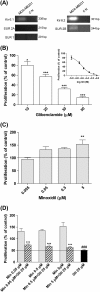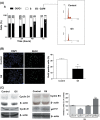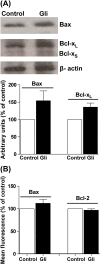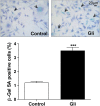Glibenclamide inhibits cell growth by inducing G0/G1 arrest in the human breast cancer cell line MDA-MB-231
- PMID: 23311706
- PMCID: PMC3558386
- DOI: 10.1186/2050-6511-14-6
Glibenclamide inhibits cell growth by inducing G0/G1 arrest in the human breast cancer cell line MDA-MB-231
Abstract
Background: Glibenclamide (Gli) binds to the sulphonylurea receptor (SUR) that is a regulatory subunit of ATP-sensitive potassium channels (KATP channels). Binding of Gli to SUR produces the closure of KATP channels and the inhibition of their activity. This drug is widely used for treatment of type 2-diabetes and it has been signaled as antiproliferative in several tumor cell lines. In previous experiments we demonstrated the antitumoral effect of Gli in mammary tumors induced in rats. The aim of the present work was to investigate the effect of Gli on MDA-MB-231 breast cancer cell proliferation and to examine the possible pathways involved in this action.
Results: The mRNA expression of the different subunits that compose the KATP channels was evaluated in MDA-MB-231 cells by reverse transcriptase-polymerase chain reaction. Results showed the expression of mRNA for both pore-forming isoforms Kir6.1 and Kir6.2 and for the regulatory isoform SUR2B in this cell line. Gli inhibited cell proliferation assessed by a clonogenic method in a dose dependent manner, with an increment in the population doubling time. The KATP channel opener minoxidil increased clonogenic proliferation, effect that was counteracted by Gli. When cell cycle analysis was performed by flow cytometry, Gli induced a significant cell-cycle arrest in G0/G1 phase, together with an up-regulation of p27 levels and a diminution in cyclin E expression, both evaluated by immunoblot. However, neither differentiation evaluated by neutral lipid accumulation nor apoptosis assessed by different methodologies were detected. The cytostatic, non toxic effect on cell proliferation was confirmed by removal of the drug.Combination treatment of Gli with tamoxifen or doxorubicin showed an increment in the antiproliferative effect only for doxorubicin.
Conclusions: Our data clearly demonstrated a cytostatic effect of Gli in MDA-MB-231 cells that may be mediated through KATP channels, associated to the inhibition of the G1-S phase progression. In addition, an interesting observation about the effect of the combination of Gli with doxorubicin leads to future research for a potential novel role for Gli as an adjuvant in breast cancer treatment.
Figures







Similar articles
-
Fluoxetine mediates G0/G1 arrest by inducing functional inhibition of cyclin dependent kinase subunit (CKS)1.Biochem Pharmacol. 2008 May 15;75(10):1924-34. doi: 10.1016/j.bcp.2008.02.013. Epub 2008 Feb 17. Biochem Pharmacol. 2008. PMID: 18371935
-
Centchroman induces G0/G1 arrest and caspase-dependent apoptosis involving mitochondrial membrane depolarization in MCF-7 and MDA MB-231 human breast cancer cells.Life Sci. 2008 Mar 12;82(11-12):577-90. doi: 10.1016/j.lfs.2007.11.028. Epub 2007 Dec 15. Life Sci. 2008. PMID: 18279897
-
Anti-tumor potential of 15,16-dihydrotanshinone I against breast adenocarcinoma through inducing G1 arrest and apoptosis.Biochem Pharmacol. 2007 Dec 3;74(11):1575-86. doi: 10.1016/j.bcp.2007.08.009. Epub 2007 Aug 11. Biochem Pharmacol. 2007. PMID: 17869226
-
Naringenin inhibits migration of breast cancer cells via inflammatory and apoptosis cell signaling pathways.Inflammopharmacology. 2019 Oct;27(5):1021-1036. doi: 10.1007/s10787-018-00556-3. Epub 2019 Apr 2. Inflammopharmacology. 2019. PMID: 30941613
-
Tehranolide inhibits proliferation of MCF-7 human breast cancer cells by inducing G0/G1 arrest and apoptosis.Free Radic Biol Med. 2012 May 1;52(9):1987-99. doi: 10.1016/j.freeradbiomed.2012.01.026. Epub 2012 Feb 4. Free Radic Biol Med. 2012. PMID: 22366652
Cited by
-
Combined treatment of glibenclamide and CoCl2 decreases MMP9 expression and inhibits growth in highly metastatic breast cancer.J Exp Clin Cancer Res. 2013 May 28;32(1):32. doi: 10.1186/1756-9966-32-32. J Exp Clin Cancer Res. 2013. Retraction in: J Exp Clin Cancer Res. 2025 Feb 4;44(1):38. doi: 10.1186/s13046-025-03311-z. PMID: 23714264 Free PMC article. Retracted.
-
PEPT1 is essential for the growth of pancreatic cancer cells: a viable drug target.Biochem J. 2021 Oct 29;478(20):3757-3774. doi: 10.1042/BCJ20210377. Biochem J. 2021. PMID: 34569600 Free PMC article.
-
Implications of NLRP3 Suppression Using Glibenclamide and miR-223 against Colorectal Cancer.Pharmaceuticals (Basel). 2024 Feb 26;17(3):299. doi: 10.3390/ph17030299. Pharmaceuticals (Basel). 2024. PMID: 38543085 Free PMC article.
-
Anti-Diabetic Therapies and Cancer: From Bench to Bedside.Biomolecules. 2024 Nov 20;14(11):1479. doi: 10.3390/biom14111479. Biomolecules. 2024. PMID: 39595655 Free PMC article. Review.
-
Type 2 Diabetes Mellitus and Cancer: The Role of Pharmacotherapy.J Clin Oncol. 2016 Dec 10;34(35):4261-4269. doi: 10.1200/JCO.2016.67.4044. Epub 2016 Nov 7. J Clin Oncol. 2016. PMID: 27903154 Free PMC article. Review.
References
Publication types
MeSH terms
Substances
LinkOut - more resources
Full Text Sources
Other Literature Sources
Miscellaneous

